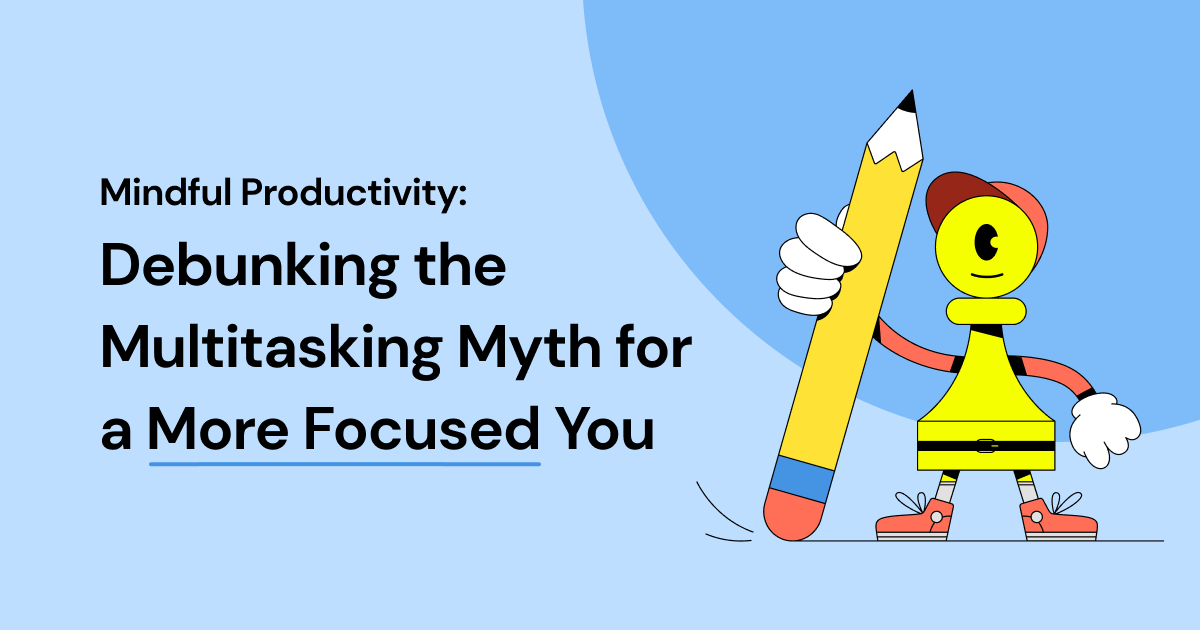As you’re working on a paper, you’re on your phone, helping a classmate solve a math problem. You’re also closely following the developments in the latest episode of your favorite TV show. And on top of that, you’re on top of all three of your freelance projects. C-R-A-Z-Y. W-I-L-D.
You can do all sorts of things simultaneously as long as the task combos don’t violate the laws of physics. And even then, you’d still do it all because you’re a multitasker. In fact, if we didn’t know that multitasking is a myth, we’d be asking you for advice on how to multitask better! But instead, our job today is to debunk this made-up phenomenon.
What Is Multitasking?
Simply put, multitasking refers to the ability to perform several things at once. However, such a skill is not a thing in real life. While the next Marvel superhero could have such a power, humans aren’t wired that way.
Lots of us can do some easier tasks simultaneously, that’s for sure. Just think of the last time you were hiking, creaking through the lyrics of a 2023 tune, and looking out for lurking grizzlies on your path. Still, we’re incapable of doing multiple complex activities all at once.
But simply defining multitasking won’t stop you from taking on millions of tasks each minute. You need to also familiarize yourself with the lies that surround this phenomenon. Read on!
5 Myths About Multitasking
As we said earlier, multitasking is a myth. Sure, you can try to be a modern-day Sisyphus and roll as many boulders up your to-do hill as you want. But facts are facts. There’s no such thing as doing it all at the same time, and the efforts to succeed in that will exhaust you. Now, let’s expose the five untruths about multitasking that you should beware of.
1. We Can Multitask
No, we can’t. Multitasking is not in our nature. Single-tasking is. It’s what our brains have evolved to do. We’re simply incapable of focusing on more than one thing at a time.
Think you’re an exception to the rule, able to do this and that in one take? Well, you’re just switching between activities in splits of a second. So, no, you’re not making it all happen at the same time.
2. Three Types of Multitasking Exist
However, things aren’t as straightforward, and the attempt to carry the world on our shoulders has three different forms. Or at least that’s what the internet says. Spoiler alert: this is yet another myth. These types of multitasking are actually the stages of attempting to multitask. Below, we briefly describe all of them and the negative impacts they have on your health and productivity:
- Multitasking
Trying to focus on two or more tasks simultaneously. Doing this can lead to them interfering with one another, which can, in turn, negatively impact your short-term memory and creative thinking, prevent you from getting into a state of flow, make you prone to committing errors, and increase your anxiety.
- Context switching
Toggling between activities. It can make you tired and less productive and slow you down.
- Completing one task after another
Doing multiple different things in rapid succession. It’s mentally straining and leaves you thinking about or feeling the impact of the previous task even after finalizing it.
3. It Isn’t Bad
If you’ve been living your life as a multitasker, you might be inclined to think that you’re indeed a talented one. In fact, you might even be wondering whether you should apply for a Guinness World Record in multitasking! However, we must tell you that you’re bad at it.
And not only are you a lousy multitasker, but you’re probably not even aware that you are. According to one study, there’s no correlation between our perceived ability to multitask and our success at doing that. That said, your idea about yourself as a super-talented multitasker is nothing but an idea.
4. There’s Nothing Wrong With Multitasking at Work
Some people don’t multitask at home. However, they do this at work. After all, most of us use many apps and devices to complete different tasks, so it’s no surprise we attempt to multitask when doing our jobs. There’s also a name for this activity: media multitasking.
However, toggling between laptops and gadgets at work is wrong. We mentioned earlier that grinding several tasks simultaneously can hurt your short-term memory. Well, doing this as part of your job can affect your short- and long-term memory, which is a real bummer.
5. It Can Make You More Productive
No, it can’t. You won’t be getting more done. If anything, you’ll be accomplishing less by the second. That’s because when you switch between contexts, you get to experience short mental blocks. These, in turn, decrease your productivity.
Yes, switching between tasks takes cognitive effort. You cannot jump from thought to thought just like that, effortlessly! And since you cannot bypass the struggle of getting all you have to do done, you’ll tire yourself quickly. How’s that being super productive?
The Effects Of Multitasking
Scientists are unanimous — multitasking does more harm than good. We already said something about its negative implications on your overall performance. However, here’s a quick list of other ways it can negatively affect your life:
- It can cause you to do worse in school.
- Trying to multitask can cause interference between the brain networks involved in cognitive control and attention, making you process information slower.
- It can negatively impact your work efficiency.
- Heavier media multitasking can make you forgetful.
- In certain situations, multitasking can even be dangerous and life-threatening, as in the case of talking on your phone while driving.
6 Ways to Be Productive Without Multitasking
Now that you know multitasking is a myth, you can try to boost your productivity differently. Monotasking or single-tasking is an excellent way to do that. It allows you to focus better and achieve your goals faster. Here’s how to single-task like a pro:
- Try time blocking
Group all similar tasks together and work and complete them in the same timeframe. For example, you could check your email and texts for an hour in the morning and dedicate two hours to your English and Geography assignments in the evening.
- Manage your time with timeboxing
Predict how long it will take you to finish a particular task and focus only on it during that time. Once you’re done with it, switch to a different one.
- Prioritize your tasks accordingly
Understand the importance of each of your tasks, and start completing them by order of immediacy. You can always mix things if a new, more critical task pops up.
- Use the Pomodoro technique
Make your breaks effective with the Pomodoro technique. Work in sessions of 25 minutes and pause for five. After four Pomodoros, you can take breaks of 20-30 minutes.
- Activate the “do not disturb” mode on your device
Avoid distractions by turning off the notifications on your phone, laptop, or any other device you might be using.
- Know your MITs
List the most important tasks you must do throughout the day. You can leave some for tomorrow if you don’t have to complete them all in a day.
Conclusion
You can always do more. However, you don’t have to do it all at once. When you eat, you chew your food. And when you dress, you put on one piece of clothing at a time. You also start with your pants because prioritization and doability matter unless you’re Superman or following a quirky fashion trend.
Of course, taking a break after making it all fit is a must. If your urge to some money grows stronger during those chillaxing moments, you can spend them using Pawns.app. Solve a few surveys, share some of your internet, and stack a cent at a time. And remember, don’t solve two polls simultaneously!


